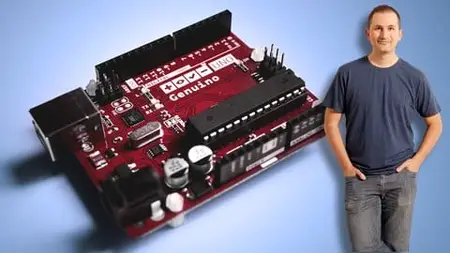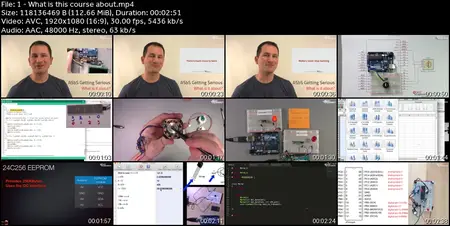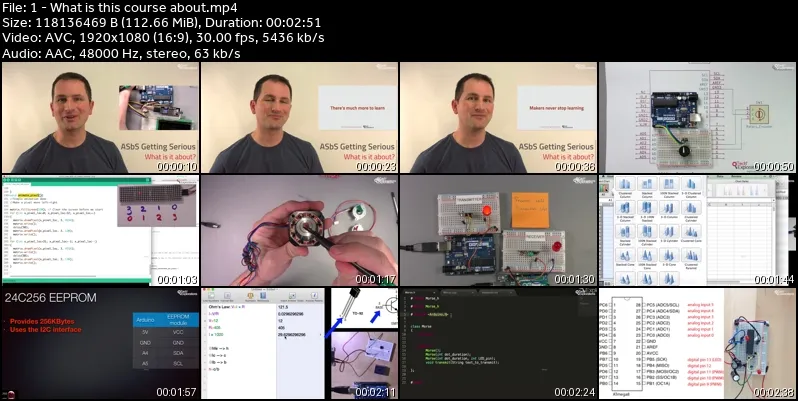Arduino Step by Step Getting Serious
2025-02-12
MP4 | Video: h264, 1920x1080 | Audio: AAC, 44.1 KHz
Language: English (US) | Size: 24.48 GB | Duration: 40h 45m
2025-02-12
MP4 | Video: h264, 1920x1080 | Audio: AAC, 44.1 KHz
Language: English (US) | Size: 24.48 GB | Duration: 40h 45m
Create Arduino gadgets that can communicate, move, interact, measure and detect.
What you'll learn
Use communications technologies like Wifi, BLE, and radio
Use servo, DC and stepper motors with various controllers
Use LCD, OLED and TFT screens with buttons and touch interfacese
Store data in external storage like SD Cards and EEPROM
Optimise a sketch to minimise memory footprint, reduce power consumption and increase performance
Control large loads like relays and lights
Improve button reliability with hardware debouncing
Much more, please see curriculum for a full listing
Requirements
You have a basic understanding of the Arduino
A copy of the Arduino IDE
You can write simple sketches
You can create small circuits on a breadboard
Basic tools, like a multimeter, a breadboard, wires, an Arduino Uno board, etc (a list of required tools and parts is available in the first section of the course, free to access)
Description
Course last updated on February 2025In this update I added three new sections at the end of the course to cover these topics:How to use a infrared receiver to control actions on your Arduino. This provides a low cost method of controlling your Arduino projects wirelessly, and provides an excellent alternative to radio control.How to use an RFID module to implement security, identification, or other automation applications. How to use a joystick as an input device. Updated of December 2024This update introduces advanced lectures on using the Wokwi simulator, a powerful tool that enhances your ability to design, debug, and analyze Arduino projects in a virtual environment. With these new lessons, you’ll explore professional-grade features that make learning and prototyping more efficient.The new Section 49: Wokwi Simulator takes your simulation skills to the next level, focusing on advanced applications and tools. Here’s a breakdown of the new lectures:• Wi-Fi with ESP32: Learn how to simulate and experiment with Wi-Fi functionality using the ESP32 microcontroller in Wokwi.• What Is This Section About?: A brief overview of how this section expands on simulator concepts.• Wokwi Refresher: A recap of foundational Wokwi concepts, building on knowledge from Arduino Step by Step Getting Started.• Shift Register with 8 LEDs: An example project demonstrating how to simulate a shift register to control multiple LEDs efficiently.• SD Card Datalogger: Learn to simulate data storage projects, including writing to and reading from an SD card.• Interactive Debugger: Explore Wokwi’s built-in debugging tools to pinpoint and resolve issues in your code.• Logic Analyzer: A two-part deep dive into using the logic analyzer for signal analysis and SPI protocol decoding.About this courseWelcome to Tech Explorations Arduino Step by Step Getting Serious, where you will extend your knowledge of Arduino components and techniques and build up new skills in the largest, and the most comprehensive course on the Web!Arduino is the world's favorite electronics learning and prototyping platform. Millions of people from around the world use it to learn electronics, engineering, programming, and create amazing things, from greenhouse controllers to tree climbing robots remotely controlled lawnmowers. It is a gateway to a career in engineering, a tool for Science, Technology, Engineering, and Mathematics education, a vehicle for artistic and creative expression.The course is split into 40 sections and over 250 lectures spanning more than 30 hours of video content. In each section, you will learn a specific topic. Each topic contains:multiple examples of codewiring schematicsdemonstrations of a completed circuitalternative scenariosPeter, the instructor, and designer of this course, helps you understand the code and the circuit wiring by walking you through them, step by step and explaining every line of code and every wire of the circuit. Students have access to:The course repository, which contains all of the sketch code, wiring schematics and external resource links, which Peter keep up-to-date and correctThe course discussion Forum, where you can ask questions. Peter monitors this Forum regularly and responds to your questionsThe Tech Explorations Makers Club private Facebook group where students can discuss their gadget ideas. Use this group to ask questions that don't fit within the context of the course, discuss your projects or help othersThis course contains:39 hours of brand new video content 12 hours of retouched video content (which I will be replacing in regular intervals with brand new content)49 sections with totally reorganised contentMore than 300 lectures (and counting)Over 100 new and updated sketches (and counting)Over 50 new circuit schematics (and counting)New course repository, reorganised so that sketches, schematics and lecture external resources are easy to find (access everything at one place)Here are some of the topics that you will learn about in this course (for a full list, please look at the course curriculum):Advanced environment, motion, position and GPS sensors.Using the Wokwi online simulator to develop Arduino projects in your browser, without real hardware. New ways to receive input from the user with keypads, potentiometers, and encoders. New ways to provide feedback to the user, with color screens, complete with a touch-sensitive surface!Awesome ways to configure LEDs, monochrome or color. Use matrix or LED strips, display text, graphics, and animation.Create motion with various kinds of motors and controllers.Networking with Ethernet and Wifi. Communications with Bluetooth, Bluetooth Low Energy, Communications with highly-reliable packet-based radio, and simple, ultra low-cost radio for less critical applicationsMultiplying your Arduino's ability to control external devices with shift registers and port expanders.Much, much more (for a full list, please look at the course curriculum)This course is not appropriate for people new to the Arduino. It will not teach you about the basics of the Arduino, like how to use the Arduino IDE, blink an LED or create a simple sketch and circuit. If you are a new Arduino maker, you should consider taking the Tech Explorations Arduino Step by Step Getting Started course first.Apart from a basic understanding of the Arduino, a student of this course must be willing to work hard. You can't learn serious skills without serious work. There are a lot of courses out there that promise you a fun and easy learning experience. This is not one of them. I promise you a lot of hard work ahead.What about tools and parts? Other than a few essential tools and parts that you can learn about in the first section of the course (which is free to watch) I only ask that you come with an appetite to learn and a willingness to work hard. The course features a large variety of parts, but you don't need (and you shouldn't) get them all to begin learning. In fact, getting all of these parts too early is not a good idea! Watch the free lecture to understand why in the first section of this course.Should you join right now?Watch the free lectures in the first section of this course before you choose to join. They contain valuable information that will help you decide if this is the right course for you. I look forward to learning with you!
Who this course is for:
Arduino makers that wish to improve their skills and knowledge, Teachers who want Arduino resources for their classroom, Maker space coordinators who are need an online resource for their members





